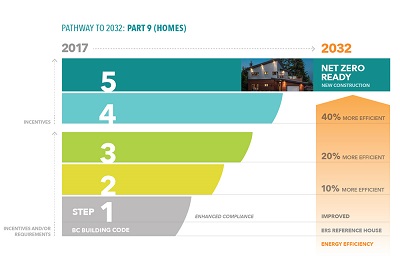 Friday, April 19, 2024
Friday, April 19, 2024  Friday, April 19, 2024
Friday, April 19, 2024 
Got news? Next submission deadline is Friday at 5:00 p.m.
Click here to submit YOUR news

The Energy Step Code project may not be sexy.
But it highlights the power of broad partnerships, and creates a path to transform the BC Building Code and slash greenhouse emissions.
The Energy Step Code is a simple plan to take the BC Building Code from where it is today to where it needs to be by 2032 to increase energy efficiency and reduce emissions.
It’s not an easy process. Building codes are highly technical, and revisions affect everyone from builders to municipalities to homebuyers.
Local governments and the residential construction industry launched the project. Both wanted to work towards reaching climate action goals, but there were no consistent standards or plan for change.
“So this group came together with the province and said, can we create a long-term stairway that helps the market transition from where we are at the moment to where we know we need to get to for climate action,” says Robyn Wark, vice-chair of the Energy Step Code council and sustainable communities team lead with BC Hydro.
They formed the Energy Step Code Council out of 25 organizations, including the Union of BC Municipalities, Local Government Management Association, the Canadian Home Builders’ Association and the Urban Development Institute, utilities and the provincial government.
The council won the Built Environment Land Award from the Real Estate Foundation of BC in October for its work in reducing carbon emissions and increasing energy efficiency.
The plan is a performance-based program with five steps. Step 1 is simply meeting the building efficiency of the current BC Building Code; it’s the baseline. Step 2 improves efficiency by 10 per cent; Step 3 improves by 20 to 40 per cent; Step 4 by 50 per cent.
The end goal, Step 5, reaches net zero building emissions from new construction.
Keep reading this blog on TheTyee.ca
Watch our video and learn more about the benefits of joining Construction Links Network – the peer-to-peer network sharing platform for the construction, building and design community.
Press Releases | Project Updates | New Appointments | Awards & Milestones | Company News | New Products/Services | Brochures | Videos | Infographics | Blog Sharing | Events and More